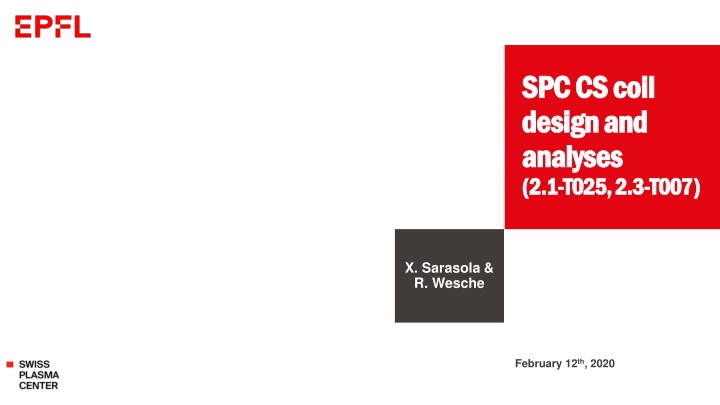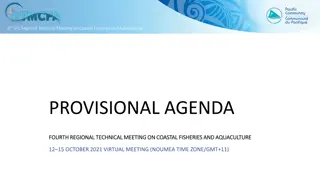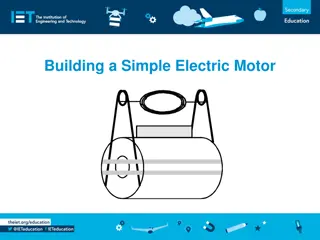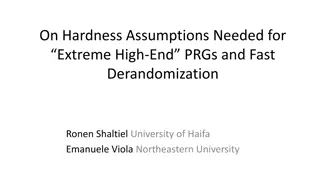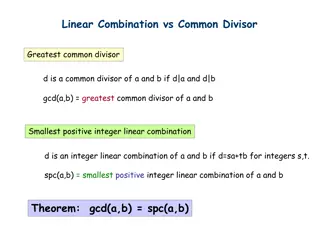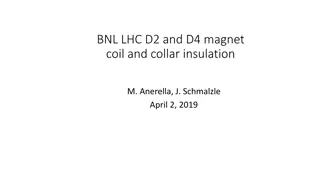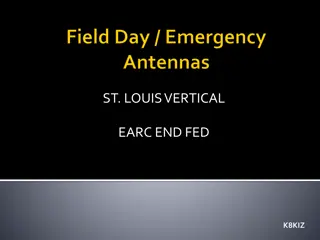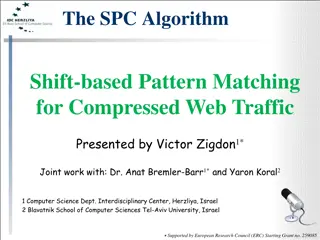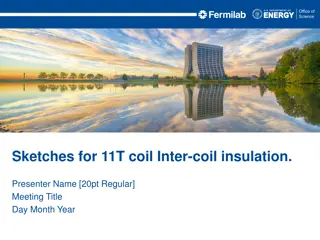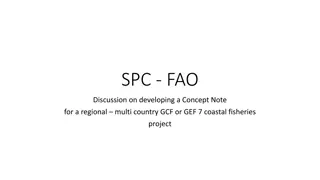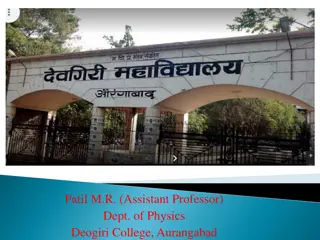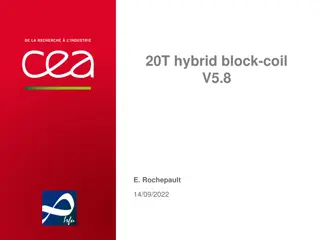SPC.CS Coil Design and Analyses: Requirements, Assumptions, and Methodology
This document discusses the design and analysis of SPC.CS coil, focusing on maximizing magnetic flux, survival under fatigue conditions, and materials used for different field layers. It covers requirements, assumptions, and the methodology for uniform current density solenoid design. The study aims to update the CS coil design to the baseline 2018 specifications, considering factors like radial space allocation, fatigue survival, and peak magnetic fields observed in different modules. The methodology includes analytical computation of magnetic field, flux, and hoop stress for different current density solenoids.
Download Presentation

Please find below an Image/Link to download the presentation.
The content on the website is provided AS IS for your information and personal use only. It may not be sold, licensed, or shared on other websites without obtaining consent from the author.If you encounter any issues during the download, it is possible that the publisher has removed the file from their server.
You are allowed to download the files provided on this website for personal or commercial use, subject to the condition that they are used lawfully. All files are the property of their respective owners.
The content on the website is provided AS IS for your information and personal use only. It may not be sold, licensed, or shared on other websites without obtaining consent from the author.
E N D
Presentation Transcript
SPC SPC CS coil CS coil design and design and analyses analyses ( (2.1 2.1- -T025, 2.3 T025, 2.3- -T007) T007) X. Sarasola & R. Wesche February 12th, 2020
Outline Outline 2 2 X. Sarasola & R. Wesche Requirements and assumptions Methodology Uniform current density vs graded designs Conclusions SPC CS COIL DESIGN AND ANALYSES
Requirements and Requirements and assumptions assumptions 3 3 X. Sarasola & R. Wesche Update the CS coil design to the baseline 2018: The generated magnetic flux is maximized for the outer radius (Ro) and height (h) given in [1]. A radial space of 115 mm is preliminary allocated for the pre-compression structure, allowing a maximum Ro = 2.7 m for the solenoid winding pack. Fatigue is the main design driver for the DEMO CS: The EU DEMO is designed to operate 20,000 plasma cycles [2]. Therefore, the CS coil design has to ensure survival of 40,000 mech cycles. The studies focus on the design of the CS1 winding pack: Layer-wound. 10 double-layer sub-coils. RE-123, Nb3Sn, and Nb-Ti are used respectively for the high, medium, and low field layers of the solenoid. SPC CS COIL DESIGN AND ANALYSES [1] R. Ambrosino, Equilibria EOF/SOF 2018 PhysMag. https://idm.euro-fusion.org/?uid=2NV5BB. [2] C. Bachmann, DEMO Plant Load Specification, 21-Sep-2017. https://idm.euro-fusion.org/?uid=2MY7H3.
Requirements and Requirements and assumptions assumptions 4 4 X. Sarasola & R. Wesche Note on baseline 2018: The peak B field is observed in module CSL2 (not CS1!) during pre-mag. It does not include 100 mm insulation spacing between the CS modules. If 100 mm spacing is included between modules: B is a bit larger (but small, in any case, B = +0.063 T compared to CS1) The current density also becomes slightly larger in CSL2 The design studies focus on the CS1 WP. No gap is considered between modules. SPC CS COIL DESIGN AND ANALYSES Baseline 2018 CSU3 12.177 12.195 CSU2 12.288 12.443 CS1 12.324 12.428 CSL2 12.329 12.491 CSL3 12.099 12.011 No mod gap With mod gap Max B (T)
Outline Outline 5 5 X. Sarasola & R. Wesche Requirements and assumptions Methodology Uniform current density vs graded designs Conclusions SPC CS COIL DESIGN AND ANALYSES
Methodology Methodology 6 6 X. Sarasola & R. Wesche In a finite uniform current density solenoid, the magnetic field, flux, and hoop stress experienced in the mid-plane, can be computed analytically. Simple parametric studies are used to find the maximum magnetic flux for a given outer radius and hoop stress. Nb3Sn ( eff= -0.25%) uniform current density, Ro= 2.7 m HTS uniform current density, Ro= 2.7 m SPC CS COIL DESIGN AND ANALYSES
Methodology: Fatigue Crack Growth Model Methodology: Fatigue Crack Growth Model 7 7 ?? ??= ? ?? Paris Law: 70 22 mm plate, 2 mm2initial surface crack Assumptions: Initial defect size: 2 mm2(surface) 5 mm2(embedded) Stress intensity factor: Elliptical cracks residual= 240 MPa Safety factors [3]: 2 in number of cycles 2 in defect area 1.5 in fracture toughness SPC CS COIL DESIGN AND ANALYSES [3] C. Jong, Magnet Structural Design Criteria Part 1: Main Structural Components and Welds, 2012. https://user.iter.org/?uid=2FMHHS.
Methodology Methodology 8 8 X. Sarasola & R. Wesche Designs with higher allowable hoop stress can operate at larger jeng(larger B and ) The benefit of using HTS dilutes for low allowable hoop stress. In order to ensure fatigue lifetime (assumptions in previous slide): The hoophas to be limited to 300 MPa if SS316LN is used for the conduits (~375 MPa in the case of JK2LB) SPC CS COIL DESIGN AND ANALYSES
Outline Outline 9 9 X. Sarasola & R. Wesche Requirements and assumptions Methodology Uniform current density vs graded designs Conclusions SPC CS COIL DESIGN AND ANALYSES
Uniform Uniform current density vs graded designs current density vs graded designs 10 10 For an allowable hoop= 300 MPa and Ro= 2.7 m, the maximum flux is generated for Ri 1.5 m. UCD The proposed Uniform Current Density (UCD) design is analyzed in ANSYS. The radial distribution of the B field is used to propose a more economically sensible superconductor (SC) graded design. SC graded SPC CS COIL DESIGN AND ANALYSES The stainless steel fraction can be adjusted across the winding pack. The radial stress in the insulation shall be always compressive The hoop stress is such that fatigue lifetime is guaranteed using jackets made of SS316LN. SC+SS graded
SPC designs (baseline 2018) SPC designs (baseline 2018) 11 11 X. Sarasola & R. Wesche LTS-only designs Design UCD SC grad SC+SS grad Total current [MAt] 71.044 Cond current [kA] 45.541 Ri[mm] 1500 1540 1540 Ro[mm] 2700 SC material subcoils [HTS/Nb3Sn/Nb-Ti] -/10/- -/7/3 -/7/3 Max B [T] 15.43 15.45 15.45 SPC CS COIL DESIGN AND ANALYSES 211.6 (+3.7%) 215.4 (+5.6%) Only CS 204 Mag flux [Wb] 225.6 (+3.5%) 229.4 (+5.2%) CS+PF 218.0 memb, L01[MPa] 358.6 352.3 347.9 hoop, L01[MPa] 289.8 292.0 291.9 Cycles until break [#] 82.4 103 84.0 103 85.4 103
SPC designs (baseline 2018) SPC designs (baseline 2018) 12 12 X. Sarasola & R. Wesche LTS-only designs HTS designs Design UCD SC grad SC+SS grad UCD SC grad SC+SS grad Total current [MAt] 71.044 72.235 Cond current [kA] 45.541 46.305 Ri[mm] 1500 1540 1540 1500 1520 1520 Ro[mm] 2700 2700 SC material subcoils [HTS/Nb3Sn/Nb-Ti] -/10/- -/7/3 -/7/3 10/-/- 1/6/3 1/6/3 Max B [T] 15.43 15.45 15.45 15.72 15.71 15.76 SPC CS COIL DESIGN AND ANALYSES 211.6 (+3.7%) 215.4 (+5.6%) 207.4 (+1.7%) 211.6 (+3.7%) 218.5 (+7.1%) Only CS 204 Mag flux [Wb] 225.6 (+3.5%) 229.4 (+5.2%) 221.6 (+1.7%) 225.8 (+3.6%) 232.7 (+6.7%) CS+PF 218.0 memb, L01[MPa] 358.6 352.3 347.9 356.0 362.1 350.0 hoop, L01[MPa] 289.8 292.0 291.9 288.9 294.5 295.4 Cycles until break [#] 82.4 103 84.0 103 85.4 103 84.2 103 80.0 103 83.6 103
Outline Outline 13 13 X. Sarasola & R. Wesche Requirements and assumptions Methodology Uniform current density vs graded designs Conclusions SPC CS COIL DESIGN AND ANALYSES
Conclusions Conclusions 14 14 X. Sarasola & R. Wesche The requirements for the CS in the Baseline 2018 are inconsistent: Given the space allocated for the CS coil, it is not possible to satisfy simultaneously two fundamental design requirements: Required magnetic flux ( = 250 Wb) Fatigue lifetime (20,000 plasma cycles + Safety factors) At low allowable hoop stress (~300 MPa), the use of HTS only provides a small gain in flux compared to Nb3Sn R&W. Use of superconductor and stainless steel grading: More cost-effective layout. Modest increase the generated magnetic flux (only a few percentage points relative to the uniform current density designs). SPC CS COIL DESIGN AND ANALYSES Other strategies to mitigate the effect of fatigue are under study (see tomorrow s presentation on mechanical analyses).
Proposal 2020 Proposal 2020 15 15 X. Sarasola & R. Wesche Further investigation of the CS coil alternative conductor design options. Dimensioning of the pre-compression structure based on Baseline 2018. Start: 01.03.2020 End: 31.10.2020 Resources: 0.2 ppy SPC CS COIL DESIGN AND ANALYSES
